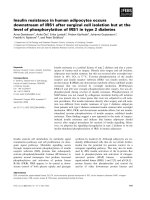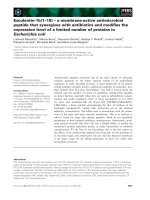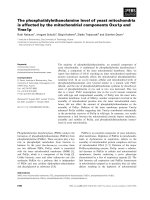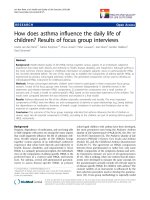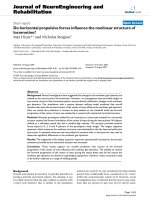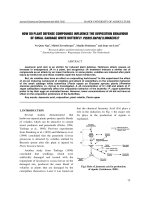cash cycle factors that influence the desired level of cash optimal cash inventories
Bạn đang xem bản rút gọn của tài liệu. Xem và tải ngay bản đầy đủ của tài liệu tại đây (1.27 MB, 33 trang )
Cash Management
Cash Cycle
Factors that influence the desired level
of cash
Optimal cash inventories
Short-term investment strategies
The Manager
Resource Decisions
Information
Decisions
Financing Decisions
Investment Decisions
Human Resources
Decisions
Managing an entity’s Resources
Cash Management
Inventory Management
Working Capital Management
Investment in Human Capital
Long-term Assets
Accounts Receivable
Economics of Information
Database Management
Data Modeling
IS Planning & Development
Debt vs. Tax Financing
Cost of
Capital
Discount Rate
Value
Creation
Financial
Markets
Cash Inflows
Operating
Decisions
Recruitment, Selection
Training, Productivity
Performance Appraisal
Compensation
Unions & Labor Relations
Life cycle effects,
Business cycle,
public events,
etc.
Overview
!"#
$#%$&'(
)'*
(!
'
Managing WC involves determing:
•
+)"#,
- CA vs. FA
- Nature of activities/programs
•
In each CA?
- Cash, A/R, Inventory
- Cash Mgt
- A/R is Credit Mgt
- Inv = POM & Cash balance models
Our objectives
•
-)""'
•
.!/)
!
•
-)
!
•
0!!
))'
1
Objectives of Public Money
Managers
2')
#)
) !!)
Key areas of Public Cash
Management
3
")!!)
4!''
&!5!)
3!
")
2
Treasury Management of
Cash Balances
3)!
)
2!
6!!)
How much cash should a
organization keep on hand?
•
7)'
8
–
(Daily or Weekly Cash Budget helpful)
•
#'!
)59)8)'
The size of the minimum cash
balance depends on:
•
+9)''
8
•
+)'
9)8
–
(Cash Budget helpful)
•
+))'
!8
The organization’s maximum cash
balance depends on:
•
#
)
–
e.g. money market funds, CDs, commercial paper
•
75)
)8
–
e.g. If expected returns are high, organizations should be quick
to invest excess cash
•
!
•
:!"!'
–
(Cash Budget helpful)
Consider Cash an ‘Inventory’
Grantsville has a daily demand for cash of $10,000.
Grantsville’s treasurer invests excess cash in the state investment pool
that earns .01% per day. In order to transfer funds from the state pool,
Grantsville must pay a transaction cost of $20. How much cash should
it transfer when it runs out. (Grantsville can complete the cash
transfer electronically so it waits until the cash balance is zero).
An inventory approach to Cash
Balance decisions:
the trade-offs: - hold little cash = invest
remainder in M/S to earn interest
the trade-offs: - hold little cash = invest
remainder in M/S to earn interest
- if hold too little cash = incur transactions
costs to meet cash needs
- if hold too little cash = incur transactions
costs to meet cash needs
- hold lots of cash = forgo investing in M/S
and earning interest
- hold lots of cash = forgo investing in M/S
and earning interest
50000000 1002 504 339.3333333 258 210
Order Quantity (Z)
Cost ($)
Z
*
Total Costs
Holding Costs:
(Z/2)*r
Order Costs:(M
/
/Z)*TC
Optimal Cash Balance via Baumol Model
Z
*
Z*= √ [(2M*TC)/r]
M = $10,000
M = $10,000
r = .01% .0001
r = .01% .0001
TC = $20
TC = $20
Z = $63,246
Z = $63,246
Problems with the Baumol Model
•
Cash flows may not be very predictable, much less
constant
•
Treasurers may want a ‘safety stock’ of cash
The Miller - Orr Model
•
;3;
!)!)
<$
)
-5'
)')
)+8
•
:=
–
transaction costs of buying or selling securities
–
variability of daily cash (incorporates uncertainty)
–
return on short-term investments
Days of the Month
D
o
l
l
a
r
s
i
n
t
h
e
C
a
s
h
A
c
c
o
u
n
t
The Miller - Orr Model
Lower Limit
Upper Limit
Z
Sell Securities
Buy Securities
H
L
The Miller-Orr Model
- Target Cash Balance (Z)
3 x TC x V
4 x r
Z = + L
3
where: TC = transaction cost of buying
or selling securities
V = variance of daily cash flows
r = daily return on short-term
investments
L = minimum cash requirement
•
75=)
)'>?'
@>A
)')"8'
!/@AAAB
')9)@$AAA)
)-8C
The Miller-Orr Model
- Target Cash Balance (Z)
3 x 50 x 1000
4 x .05/360
Z = + $1,000
= $3,000 + $1,000 = $4,000
3
The Miller-Orr Model
- Upper Limit
•
)!)+
'9)=
+D<*-
=
<
--
•
&)5=
+D@E$AAA*@$AAA@A$AAA
Days of the Month
D
o
l
l
a
r
s
i
n
t
h
e
C
a
s
h
A
c
c
o
u
n
t
The Miller - Orr Model
Lower Limit
Upper Limit
$4000
Sell Securities
Buy Securities
$10,000
$100
0
Cash Pooling
"
!
!'5!
9)'
)8
6)
2
Investment of excess
funds
The Collection & Disbursement of Public Funds
Controlling Cash
Collection &
Disbursement
•
:)'
•
%
!
F
•
"!
)
Managing Cash
Balances
•
!'
•
-9)'
•
;5 !
!)
!
–
Concentration Accounts
–
Zero-balance accounts
•
+'
Collection of funds
4!
+!
